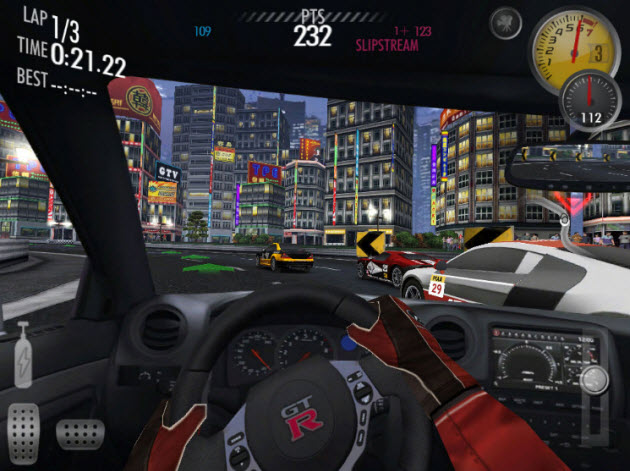 I picked up an Apple iPad on Saturday with the mission of checking out how good a device it is for gaming. I’ll be writing about various hot iPad games over time, but these are my first impressions.
I picked up an Apple iPad on Saturday with the mission of checking out how good a device it is for gaming. I’ll be writing about various hot iPad games over time, but these are my first impressions.
From a strategic view, Apple has to nail gaming. Other apps might take off gradually. But gaming should be intuitive on this device, and the possibilities here are going to make rivals such as Nintendo and Sony worried about whether they can hang on to their core portable gaming audiences. Steve Jobs may have bigger ambitions than gaming on his mind, but he cannot fail here, because gamers are early adopters and because games are the most important apps today in terms of volume, variety and momentum.
There are pluses and minuses to the iPad as a gaming device. But the most flattering thing I can say about it is that the iPad marks the beginning of a new kind of gaming. It makes possible new kinds of scenarios, like sitting on the couch and showing someone else a game as you play it, or getting lost in the great visuals of a portable game in the same way that you get immersed as you watch a high-definition flat-panel TV. Game developers are going to have to learn how to exploit this unique platform.
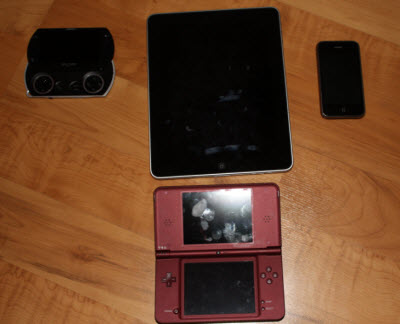 As you can tell by the image at the right, there is no portable gaming device with a screen that is anywhere near as big and beautiful as the screen on the iPad. (It’s far bigger than Sony’s PSPgo, pictured left, the iPhone, pictured right, and the Nintendo DSi XL pictured bottom). That screen is so big that Nintendo really ought to call its new handheld the “XS” for its extra-small screen, as opposed to XL for extra large.
As you can tell by the image at the right, there is no portable gaming device with a screen that is anywhere near as big and beautiful as the screen on the iPad. (It’s far bigger than Sony’s PSPgo, pictured left, the iPhone, pictured right, and the Nintendo DSi XL pictured bottom). That screen is so big that Nintendo really ought to call its new handheld the “XS” for its extra-small screen, as opposed to XL for extra large.
When you hold that screen just a foot or two from your face, it’s a truly immersive experience. You don’t have to squint at small text to read captions on the screen (yes, it’s a great gaming device for old folks like me who can’t seen tiny screens). You don’t notice your surroundings, so it’s not a good idea to play a game on this device while you’re walking down a busy city street.
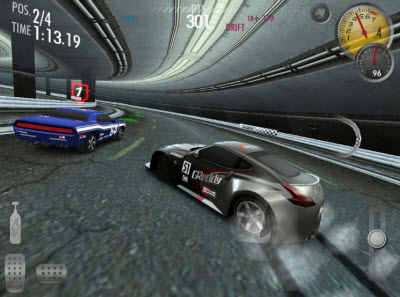 The screen is mesmerizing for games. I launched Electronic Arts’ Need for Speed HD for the iPad (pictured at top and right). The sound blew my ears out (I was listening on a headset, since that’s the way you get stereo sound; it’s too bad you can’t get stereo otherwise). The visuals were also stunning. I looked closely for blurred imagery or pixelated sections of the animations. The flaws are there, but they’re not really noticeable. EA did a great job creating a high-speed racing game with beautiful visuals and simple driving controls. There were no hiccups in the movement, since the iPad has a lot of processing horsepower under the hood.
The screen is mesmerizing for games. I launched Electronic Arts’ Need for Speed HD for the iPad (pictured at top and right). The sound blew my ears out (I was listening on a headset, since that’s the way you get stereo sound; it’s too bad you can’t get stereo otherwise). The visuals were also stunning. I looked closely for blurred imagery or pixelated sections of the animations. The flaws are there, but they’re not really noticeable. EA did a great job creating a high-speed racing game with beautiful visuals and simple driving controls. There were no hiccups in the movement, since the iPad has a lot of processing horsepower under the hood.
The big screen is also good for socializing with the iPad. I had a lot of fun playing EA’s Tetris HD for the iPad and showing it to my kid, who had never seen the game before. We just sat on the couch together and both of us had no problem watching the action at the same time.
But there are some problems that make the device less than ideal in a number of ways. The Home button in the bottom of the screen is in a spot where you might want to rest your fingers while playing. If you tap it by accident, then you exit your game. That’s the only button on the screen. Apple’s dislike of buttons means, as with the iPhone, there are only two ways you can control iPad games. You can steer by turning your hands or shake the iPad to activate its motion-sensing accelerometer. You can also tap your fingers on the multitouch screen, which can detect multiple fingers on the screen at the same time.
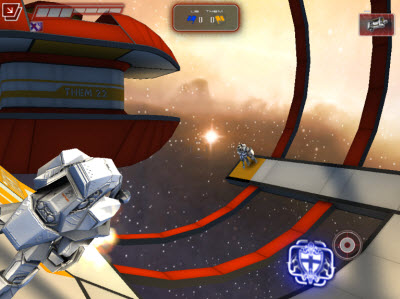 The multi-finger touch adds a lot to the gaming experience. In SGN’s new game, EXO-Planet (right), for instance, you tap the screen once to make your spacesuit warrior start flying through zero gravity toward a target. But if you tap the screen with two fingers, the warrior starts firing a weapon. So it’s the same gesture, but it controls something different. That’s how game developers can start adding complexity to their game controls for more complex games.
The multi-finger touch adds a lot to the gaming experience. In SGN’s new game, EXO-Planet (right), for instance, you tap the screen once to make your spacesuit warrior start flying through zero gravity toward a target. But if you tap the screen with two fingers, the warrior starts firing a weapon. So it’s the same gesture, but it controls something different. That’s how game developers can start adding complexity to their game controls for more complex games.
One of the problems with the touchscreen is its sensitivity, or lack of it. I noticed this while playing Electronic Arts’ iPad version of Mirror’s Edge. In the game, you play a runner who has to jump across buildings, parkour style, to deliver messages hand-to-hand in a time when all communications are monitored. You swipe your hand across the screen to make your runner, Faith, start running across the screen. You swipe down so that she can slide under and obstacle or guard, and swipe upward to make her jump. It is a wonderfully intuitive idea for controlling a game.
The problem is that the iPad screen isn’t responsive enough. Most of the time, the screen moves with lightning speed when you swipe your finger across the surface. That is a wonderful thing to see, since the screen shifts from side to side or up to down quickly. But at other times, when your finger hits the screen, nothing happens. You sometimes have to swipe twice just to make Faith jump once. It’s quite easy to mess up your well-timed jumps in the game, costing you valuable seconds in a race against time.
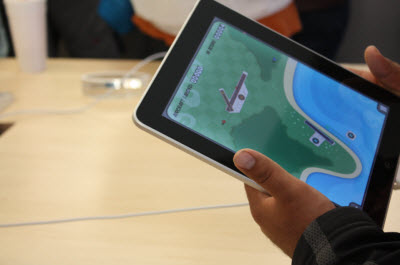 You also have to get some kind of screen stand ($39.95 for the one I bought). That way, you don’t have to worry about using a bunch of your fingers (which should be tapping or swiping the screen) to hold the screen steady. As you can see in this picture, your thumbs might be the only free digits available if you are playing while holding the screen.
You also have to get some kind of screen stand ($39.95 for the one I bought). That way, you don’t have to worry about using a bunch of your fingers (which should be tapping or swiping the screen) to hold the screen steady. As you can see in this picture, your thumbs might be the only free digits available if you are playing while holding the screen.
Of course, if you really do need a screen stand to play, it becomes kind of hard to play games on the couch where you’re balancing the iPad on your thighs. I think the best way to play is sit on a couch cross-legged with the iPad cradled in your lap so that your hands are free. If this makes you think of some weird kind of “Gamasutra” position, you’re not alone. As liberating as the big screen and the mobility of the device are, they are also constraining as well. This is clearly a device with limitations.
I hope the multitouch screen accuracy gets better over time, either through software or hardware upgrades. That’s a problem that I hope can be fixed. In the meantime, I’ll be on the lookout for the killer app game on the iPad. Game systems usually need a killer app to take off. Nintendogs, for instance, was such a fun pet simulation that it helped the Nintendo DS trounce the Sony PlayStation Portable.
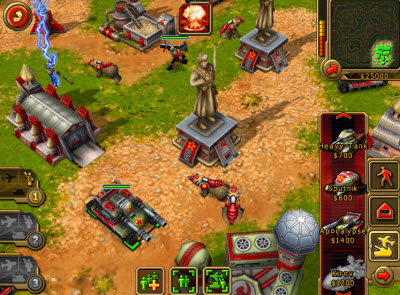 As I was searching, I lost patience with some games. EA’s Command & Conquer Red Alert (yes, it was kind of an EA day for me) was difficult to control. That real-time strategy game is really best played on a PC and there isn’t really much point in trying to make it playable on the iPad. EA dumbed it down by making fewer units available on a screen, but those units (such as tanks and infantry) were pretty dumb. They just wouldn’t listen to me when I used my finger to order them to do something.
As I was searching, I lost patience with some games. EA’s Command & Conquer Red Alert (yes, it was kind of an EA day for me) was difficult to control. That real-time strategy game is really best played on a PC and there isn’t really much point in trying to make it playable on the iPad. EA dumbed it down by making fewer units available on a screen, but those units (such as tanks and infantry) were pretty dumb. They just wouldn’t listen to me when I used my finger to order them to do something.
I haven’t found the iPad’s killer app so far, but I’m very excited about exploring what is possible. There are already tens of thousands of iPhone games that can play on the iPad. I gave the iPhone version of Doom Resurrection a whirl on the iPad and it looked stunning. And there are lots of games among the 3,000 or so apps that launched on the iPad in the past couple of days. (Flurry estimates that about 44 percent of the apps being designed for the iPad are games.)
For gamers, price will come into the picture at some point. At $499 at a minimum, the iPad is expensive. Compare that to a $199 iPod Touch or iPhone, a $199 DSi XL, or a $249 Sony PSPgo. It’s not really competitive in that respect. But the good thing is that there are a lot of free games on this device and there are a lot of cheap games, ranging from 99 cents to $14.99. So while you may dish out more for the hardware, you’re likely to spend less on software.
I wouldn’t say I’m so excited about the iPad that I would lick it or clutch it as someone tried to pry it from my cold, dead fingers. But I am the most excited I’ve been about a new piece of gaming hardware since I got an iPhone. I’m looking forward to seeing how game developers use their imagination to create games that tap the uniqueness of the iPad.
VentureBeat's mission is to be a digital town square for technical decision-makers to gain knowledge about transformative enterprise technology and transact. Learn More
